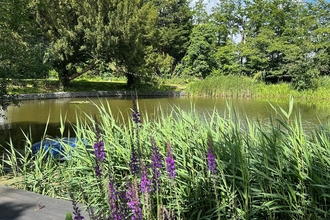Around the county, Kent Wildlife Trust's dedicated Wild About Gardens volunteers are opening their lovely gardens to the public. Whether you are a beginner or an expert, we hope you will visit a garden near you to get inspiration and information about nature-friendly gardening from knowledgeable volunteers. To mark National Gardening Week (1-7 May) here is a sneak peek at a nature-friendly garden in spring before it opens to the public in June.
A place for people and wildlife
When Penny and Peter Brook moved to their riverside Edenbridge home in 1995, they aimed to create a garden that would be a lovely place to relax with friends and family. They also wanted to encourage wildlife for their own enjoyment and interest and to do their bit to compensate for habitat loss elsewhere. They planned the garden to provide the wildlife essentials of food, shelter, water and a safe environment. In doing this, they found they were creating a garden that would be full of visual interest throughout the year.
Penny and Peter like to have a cup of tea or glass of wine in the garden, enjoying the flowers and observing the wildlife. Nature-friendly gardening means taking a relaxed approach to tidiness and can free up time to appreciate your outdoor space.

